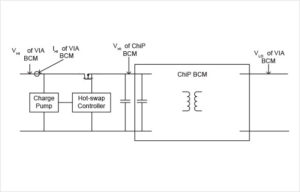Many large systems, such as data centers, rely on hot-swap (also sometimes called “hot plug”) to allow modules to be changed without powering down the system. This ability to replace faulty modules, while the remaining ones continue to function as normal, is critical if high levels of system uptime are to be achieved.
Removing a faulty module from the rack is relatively easy, provided the remaining power modules can support the step decrease in load. Plugging in the replacement module, however, has a greater potential to cause problems, as it will present an uncharged capacitor load and draw a large inrush current. This could cause a momentary, but unacceptable interruption or sag to the backplane power bus if the current drawn is not limited. Using ordinary power module connectors can also cause similar problems, since the connector pins will engage and disengage in a random and unpredictable sequence during insertion and removal.
A number of related phenomena occur with a live insertion and removal event, including bouncing, arcing between HI side connector pins, larger voltage and current transients. Hot swap circuitry in the converter modules protects the module and the rest of the system from the problem associated with live insertion.
With many applications, particularly in the telecoms, datacoms and server industries, now using a power architecture based on a 380VDC distribution bus. Using HVDC increases efficiency over lower voltage busses, but exacerbates many of the problems associated with hot swap.
To meet the need for maintenance, reconfiguration, redundancy and system upgrade, Vicor’s BCM power components are designed to enable hot-swapping at the 380VDC distribution bus. Hot swap circuitry as shown in Figure 1 uses an active MOSFET switching device in the HI side line. During insertion, the MOSFET is driven into a resistive state to limit the inrush current, and then when the inserted module’s HI side capacitor has charged, the MOSFET becomes fully conductive to avoid the voltage drop losses. Performance verification is further illustrated through scope plots of circuit’s response to various live insertion events. The BCM is therefore ideal for modules that are used in systems with 380 V power distribution as it provides high efficiency, excellent power density as well as supporting key functionality such as hot-swap.
For more information Visit: http://powerblog.vicorpower.com/2017/01/hot-swappable-bcms-increase-system-uptime/




